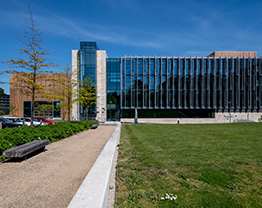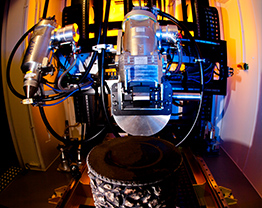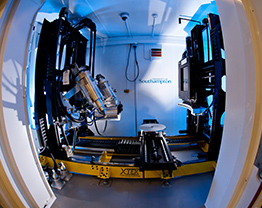Topic:
Geomechanics and environmental geotechnics
Summary:
Mechanisms of railway track behaviour encompassing stiffness, robustness, longevity, and noise and vibration effects; Engineering, environmental and economic performance of track; Reducing whole life costs and improving reliability for all track forms; Developing tools for reliable whole life assessment; Monitoring, strengthening and improving earthworks; Ballasted railway track at line speeds up to 360km/h; Innovative maintenance methods for wheels and rails; Low cost continuous self-monitoring and condition reporting for rail infrastructure, eg earthworks/embankments, OLE and bridges; Multifunctional materials, structures and foundations for OLE; Identification and assessment methods for bridge scour; Role of operational changes (eg headways) and infrastructure improvements (eg switches and crossings) in increasing capacity
Project examples:
Science & analytical tools to design long life, low noise railway systems, Track systems for high speed railways: getting it right, The design of railway overhead line equipment mast foundations, "A Guide to Track Stiffness" - a guide for practising engineers
Topic:
Railway noise and vibration
Summary:
We investigate the fundamental mechanisms behind the generation of noise and vibration and use this understanding to develop practical solutions. We have developed the TWINS program, the state-of-the-art method of predicting rolling noisem and a simplified model in the STARDAMP project to assess the benefits of different wheel and rail damping solutions. The Acoutrain project aims to replace measurements by simulation in the approval process for new trains. We have developed dedicated prediction models for ground vibration and ground-borne noise. We are researching the use of numerical techniques and semi-empirical methods for predicting aerodynamic noise at speeds above 300km/h and are active in other areas including curve squeal, impact noise, bridge noise and roughness growth.
Project examples:
MOTIV, ACOUTRAIN, A holistic approach for the design and assessment of railway tracks, Noise and Vibration Mitigation and Prevention Solutions (In2Track2)
Topic:
Whole life cost and carbon modelling, demand modelling and appraisal
Summary:
Integrated models for the prediction of track deterioration and maintenance planning; whole life cost and carbon modelling; capacity and demand modelling of current and future national transport infrastructure; relating capacity utilisation indices to the propagation of delays; optimising capacity at railway nodes; spatial modelling and visualisation to assess the case for investment in new rail infrastructure.
Project examples:
Developing Integrated Tools To Optimise rail systems (DITTO), Infrastructure Transitions Research Consortium, An Integrated Appraisal Tool for Local Railway Stations, Overcoming Capacity Constraints: A Simulation Integrated with Optimisation at Nodes (OCCASION)
Topic:
Climate change, coastal erosion and bridge scour in rivers and estuaries
Summary:
Mechanisms of scour in estuaries and rivers; extreme weather hazard; hydrological modelling; modelling and analysis of scour evolution; scour characterisation and monitoring; scour remediation and mitigation; operations and emergency responses; process and data management; permanent and temporary remote high accuracy monitoring of scour in real time. High resolution marine geophysics and geology, with particular emphasis on bed-structure interactions.
Project examples:
Review, assess and recommend development of NR's bridge assessment and extreme weather planning, integrating COAstal Sediment SysTems (iCOASST), "Assessing the effects of debris accumulations at river bridges" - a guide for practising engineers, Hydrodynamic and Geotechnical Controls of Scour Around Offshore Monopiles,
Topic:
Tribology (interacting surfaces in relative motion)
Summary:
Consultancy and research solving next generation tribological design issues, to enable surface interactions to occur with minimal enerty loss and impact on the environment; enhanced capabilities in advnaced computational and experminetal tribology; strategic research partnerships worldwide.
Our researchers work across a wide number of application areas, covering topics from aerospace and automotive materials to energy materials, surface engineering to corrosion, electrochemical engineering to artificial hips, microsystems to 3D printing, micro dry powder dispensing to tribology, tomographic imaging to artificial intelligence.
Project examples:
The Adhesion Rail Riddle - ensuring trains can brake, Forensic examination of rail axle bearings, Health monitoring of new generation aircraft bearings, A study of White Etching Crack (WEC) root causes and its relation to material microstructures and surface treatments,
Topic:
High voltage systems, dielectric materials and insulation systems
Summary:
One of the main UK high voltage research facililities, with expertise ranging from nanoscale insulation materials and plasma, through to electrical power systems and sustainable energy generation: from nanometres to megavolts. Condition monitoring of transmission plant; on-line condition monitoring of long cable circuits (20km+); condition assessment of transformers; modelling the environmental conditions in which electrical plant is likely to operate; design of dielectric for specific properties; commercial development testing, type approval, material characterisation, forensic analysis and FEA modelling (mechanical, thermal, electrical)
Project examples:
Network Rail: Cost Efficient Electrification - Electrical Testing, Optically based partial discharge (pd) data transmission system, Failure modes of transformers, Cable rating for circuits routed through tunnels,
Topic:
Aerodynamics
Summary:
Fundamental fluid dynamics, computational aeroacoustics, applied aerodynamics and flight dynamics. Excellent computational and experimental facilities. High performance workstations are supplemented by local parallel computers based on commodity processors. We lead the UK Turbulence Consortium, providing access to the largest supercomputers in the country.
We have a range of wind tunnels. The two largest have test sections measuring 3.5m by 2.6m and 2.1m by 1.7m and are equipped with rolling roads, three-axis laser doppler anemometry and motor drive systems for propeller testing. Facilities cover the full spectrum of low-speed, transonic, supersonic and hypersonic flow. A flight simulation laboratory is being used to develop cost effective simulation tools for the aerospace industry.
Project examples:
Track systems for high speed railways: getting it right, Universality of fine scale turbulence, Aspects of Reduced Order Modelling in Nonlinear Systems,Track systems for high speed railways: getting it right, Universality of fine scale turbulence, Aspects of Reduced Order Modelling in Nonlinear Systems
Topic:
Human factors
Summary:
(Behavoural) Improving and optimising human performance in systems, especially with the introduction of new technology and automation. Analysing accidents and making recommendations for accident prevention in the future.
(Physical response) Community response to vibration in buildings, passenger comfort in railway vehicles, motion sickness, human responses to combined noise and vibration, subjective responses to shock. Facilities include 6-axis motion simulator, vertical vibrator, horizontal vibrator, 12m tilting and translating cabin, turntable, treadmill and electrodynamic shakers.
Project examples:
Application of contemporary systems-based methods to reduce trauma at rail level crossings, Biodynamics of the seated body with vertical excitation, Multi-body biodynamic modelling







